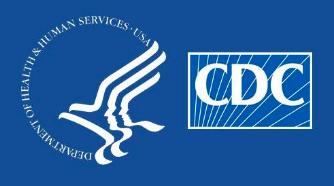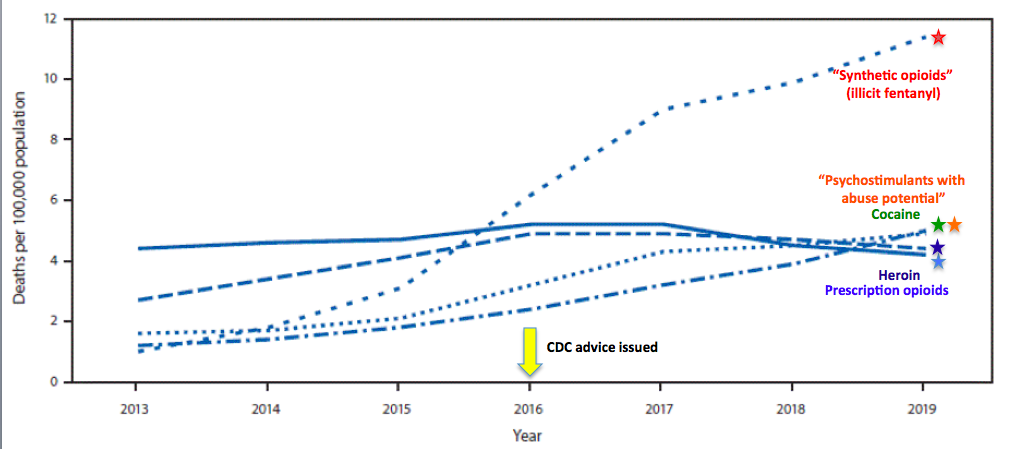
Good Morning PROP members (1). Did you sleep well? I sure hope so, but if not, it's understandable. Perhaps you and the rest of your "co-conspirator" anti-opioid zealots got an advance look at today's (February 12) Morbidity and Mortality Weekly Report (MMWR), Trends and Geographic Patterns in Drug and Synthetic Opioid Overdose Deaths — United States, 2013–2019.
If not, be prepared. There is no conceivable way that it makes you guys (and the faceless CDC drones that took your advice) look like anything except a) bungling incompetents, or b) malevolent frauds. You pick.
If it weren't painfully obvious how much damage that the "advice" spelled out in the 2016 CDC Guideline for Prescribing Opioids for Chronic Pain has done before, it is now undeniable. Even putting aside the horrors inflicted upon pain patients by your unrelenting attack on the effective and essential prescription opioid analgesic medications, the damage that was done to people who abused these drugs is incalculable.
Check that. It actually is calculable – something that becomes immediately evident upon even a cursory look at today's MMWR.

Figure 1. Deaths per 100,000 of different drugs, 2013-19. Original source: National Vital Statistics System, Mortality File. https://wonder.cdc.gov/.
* Note that I have equated "synthetic opioids" with "illicit fentanyl and its analogs," and for a reason. It makes no difference whether a drug is synthetic or naturally occurring. It's an artificial distinction; only the properties of the drug, not its source matter." Synthetic opioids" include all fentanyl analogs and tramadol (2). Tramadol, which shouldn't even be in the same class as fentanyl, is such a minor contributor to OD deaths that for all practical purposes it is accurate to say that when you see "synthetic opioids" you can just substitute fentanyl & analogs.
Figure 1 alone tells you just about everything you need to know about the so-called opioid crisis and our futile attempts to control it. Between 2013-19 the number of drug overdose deaths from all drugs rose from about 44,000 to over 70,000, an increase of roughly 57%. Of particular interest is which drugs were responsible for the increase:
- Illicit fentanyl - 1040% (11-fold)
- Stimulants (mostly methamphetamine) - 317% (4-fold)
- Cocaine - 206% (3-fold)
- Heroin - 63%
- Prescription opioids, such as oxycodone and hydrocodone - decreased by 4.2%. Let's call that unchanged.
Then there's this:
In 2019, a total of 70,630 drug overdose deaths occurred in the United States; approximately one half involved synthetic opioids. From 2013 to 2019, the age-adjusted synthetic opioid death rate increased sharply by 1,040%, from 1.0 to 11.4. Death rates involving prescription opioids and heroin increased in the presence of synthetic opioids (from 0.3 to 1.8 and from 0.1 to 2.7, respectively), but not in their absence.
Christine L. Mattson, PhD, et. al., MMWR Weekly / February 12, 2021 / 70(6);202–207
[Translation: Deaths from prescription opioids did not increase unless taken with fentanyl.]
What else can I say? By limiting the supply of prescription opioids both users and abusers switched to more dangerous drugs resulting in a 57% increase in overdose deaths and the imposition of (bad) medicine on pain patients and their doctors. An abject failure by any measure.
It would be wrong not to include a 2015 quote from Tom Frieden (3), the head of the CDC from 2009-2017 who with abundant input from PROP, was responsible for the disastrous 2016 Guideline document (emphasis mine):
"The increasing number of deaths from opioid overdose is alarming...The opioid epidemic is devastating American families and communities. To curb these trends and save lives, we must help prevent addiction and provide support and treatment to those who suffer from opioid use disorders."
Tom Frieden, MD, PhD, Medscape, 2015
How's that working out?
NOTES:
(1) PROP is an acronym for Physicians for Responsible Opioid Prescribing, easily the most anti-opioid NGO. They are not terribly popular with pain patients. Andrew Kolodny founded PROP. He's even less popular.
(2) This category is often defined as "synthetic opioids not including methadone." Why? Who knows?
(3) Frieden was the commissioner of the New York City Department of Health and Mental Hygiene from 2002 to 2009. During that time Andrew Kolodny became the Chief Medical Officer of Phoenix House and also founded PROP. Things went downhill from there. Fast.



